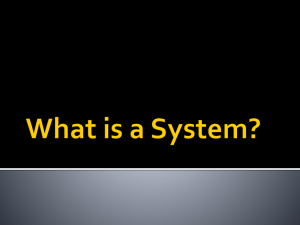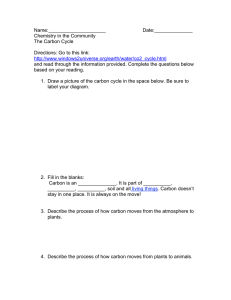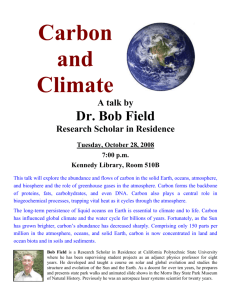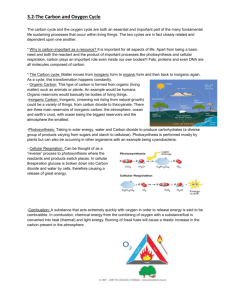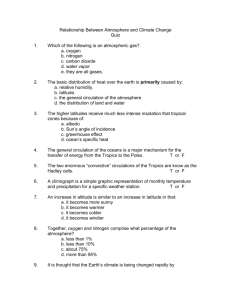The Sulfur and Carbon Cycle
advertisement
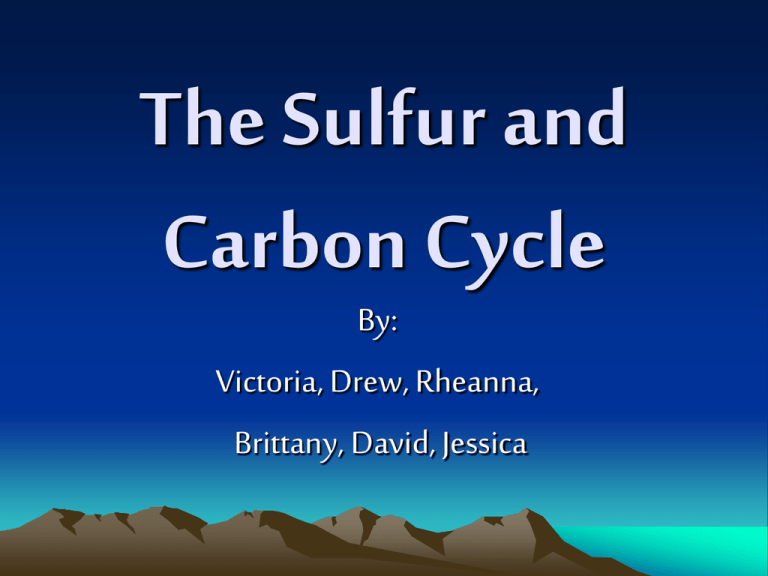
The Sulfur and Carbon Cycle By: Victoria, Drew, Rheanna, Brittany, David, Jessica Carbon Cycle Chemical Reactions Involved: • Photosynthesis: Air and water molecules and the energy from the sun to produce a simple sugar such as glucose and oxygen molecules as a by product. During photosynthesis plants use carbon dioxide and produce oxygen. Combustion/Metabolism Reaction • During combustion/metabolism oxygen is used and carbon dioxide is a product. The whole purpose of both processes is to convert chemical energy into other forms of energy such as heat. Inorganic Reservoirs •NONE Organic Reservoirs • The oceans are a major carbon storage of a reservoir. They contain dissolves oxygen and carbon in the water. (Example) As water warms, more dissolved carbon returns to the atmosphere, just as more carbon dioxide fizzes out of a carbonated beverage when it warms. • Terrestrial rocks • Fossil Fuels • The atmosphere (mainly carbon dioxide) • Land food webs (producers, consumers, decomposers, and detritivores) Pathway of Movement • • • • In the atmosphere carbon is stored as CO2, methane (CH4), and other organic compounds. These move into the atmosphere from decomposition of matter, respiration of organism, combustion, volcanic activity, burning fossil fuels, and others. Carbon moves out of the atmosphere by photosynthesis, dissolution of water, and weathering of rock. The plants use photosynthesis to take CO2 out of the atmosphere to make sugars. In the hydrosphere carbon is stored as dissolved CO2 in water. Gaseous carbon dissolves into the ocean because it is cold. Carbon moves out of the oceans by photosynthesis (plankton and cyanobacteria), degassing of warm seas, and deposition in marine sediments. In the biosphere carbon is stored as living or recently dead animals, plants, or micro-organism in the oceans and on land. Carbon moves out of the biosphere by respiration and decomposition. Impact of Human Intervention • Withdrawing large quantities of fresh water, in some heavily populated or heavily irrigated areas, these have led to ground water depletion or intrusion or ocean salt water into underground water supplies. • Clearing vegetation for various reasons 1) Increases runoff 2) Reduces infiltration that recharges ground water supplies 3) Increases flood risk 4) Accelerates soil erosion • Modifying water quality by 1) Adding nutrients and other pollutants 2) Changing ecological processes that purify water naturally Sulfur Cycle Chemical Reactions Involved • The chemical processes help produce hydrogen In the atmosphere. • When the sulfur and the water in the atmosphere mix they make sulfuric acid which is put into the rain and put onto the earth surface Pathway of Movement • Sulfur is put into the atmosphere by volcanoes • • • • and factories putting it out Sulfuric acid is rained and made into fog which puts it into the oceans and onto the land. On the land the plants absorb the sulfur, which is eaten by the animals When the plants and animals die their sulfur gets put back into the earth Then the sulfur from the earth gets put back into the magma which is erupted by the volcanoes and the land is used by some factories Organic Reservoirs • Soil • Plants Impact of Human Intervention • We are tying to come up with cleaner ways to run factories so we put less sulfur into the atmosphere thus reducing the sulfuric acid in the rain which makes it better for the plants Inorganic Reservoirs • Deep oceanic rock • Sediments • Freshwater • Ice • Atmosphere • Seas



